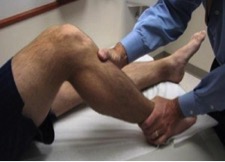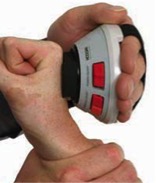Manual muscle testing (MMT) is a popular strength assessment used by physical therapists to reliably determine benefit of rehabilitative exercise and other treatments. The muscle’s ability to produce tension can provide much needed insight into a patient’s injury or illness. Proper manual muscle testing techniques are a simple and accurate way to uncover improvement or deterioration in muscle strength all over the body. However, there are several limitations to basic manual muscle testing procedures which over time have allowed some people to call into question the reliability. Physical therapists can increase objectivity of test results by implementing popular muscle testing devices like hand dynamometers and pinch strength gauges.
Manual Muscle Testing Example
MMT is known to be the most widely used method of strength assessment by physical therapists. The basis for most evaluations are based on a system of measuring the force a patient can generate in a certain direction, usually toward the therapist or person performing the test. Often gravity is used to isolate certain muscle groups and reduce subjectivity of the exam.
Popular tools for manual muscle testing like force gauges and hand dynamometer have been developed to reduce the margin of error and subjectivity of muscle tests from patient to patient. Muscle testing tools allow the examiner to easily establish their balance, immobilize the patient, and consistently measure peak force accurately.
Limitations of Manual Muscle Testing Procedures
The fact that many muscle testing grades are largely based on the examiners judgment. Examiners are required to develop an internal basis for comparing test results which make it difficult to establish generic normative values and complicate attempts at collaboration upon a patient’s prognosis.
Beasly found that physical therapists using MMT were unable to identify up to 50% of loss of knee extensor muscle strength in patients
Manual Muscle Testing Devices Are Most Reliable
As mentioned earlier, implementation of calibrated muscle testing devices greatly reduces the likelihood margin for error in MMT procedures. Using high quality medical devices and bed side communication are essential for modern muscle testing and evaluation.
Hand Held Dynamometer Used for Muscle Testing
In a study performed by Wakim-Porter a sample group of 128 patients were tested using both manual muscle testing procedures and again using hand held dynamometers. The examiners were consistently able to detect unilateral weakness more accurately after another examiner who had also detected weakness. Using only MMT techniques almost 50% of examiners were unable to detect weakness discovered by another tester but when a hand dynamometer was used that figure was closer to 90%.
Most physical therapists have come to utilize a little bit of both MMT techniques and strength evaluation devices. When it comes down to it, it is more of a personal preference. More experienced physical therapists will probably have more confidence in their internal ability to detect muscle weakness and newer PT’s will probably take comfort in the aid of a muscle testing tool. The need for accurate reliable strength measurement is undeniable and it would be in everyone’s best interest to utilize all tools and procedures at their disposal.


